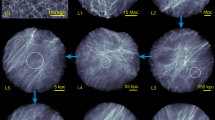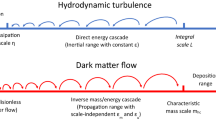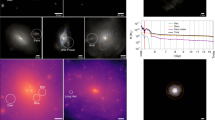Abstract
The Universe was nearly smooth and homogeneous before a redshift of z = 100, about 20 million years after the Big Bang1. After this epoch, the tiny fluctuations imprinted upon the matter distribution during the initial expansion began to collapse because of gravity. The properties of these fluctuations depend on the unknown nature of dark matter2,3,4, the determination of which is one of the biggest challenges in present-day science5,6,7. Here we report supercomputer simulations of the concordance cosmological model, which assumes neutralino dark matter (at present the preferred candidate), and find that the first objects to form are numerous Earth-mass dark-matter haloes about as large as the Solar System. They are stable against gravitational disruption, even within the central regions of the Milky Way. We expect over 1015 to survive within the Galactic halo, with one passing through the Solar System every few thousand years. The nearest structures should be among the brightest sources of γ-rays (from particle–particle annihilation).
This is a preview of subscription content, access via your institution
Access options
Subscribe to this journal
Receive 51 print issues and online access
$199.00 per year
only $3.90 per issue
Buy this article
- Purchase on Springer Link
- Instant access to full article PDF
Prices may be subject to local taxes which are calculated during checkout



Similar content being viewed by others
References
Peebles, P. J. E. Large-scale background temperature and mass fluctuations due to scale-invariant primeval perturbations. Astrophys. J. 263, L1–L5 (1982)
Hofmann, S., Schwarz, D. J. & Stöcker, H. Damping scales of neutralino cold dark matter. Phys. Rev. D 64, 083507 (2001)
Berezinsky, V., Dokuchaev, V. & Eroshenko, Y. Small-scale clumps in the galactic halo and dark matter annihilation. Phys. Rev. D 68, 103003 (2003)
Green, A. M., Hofmann, S. & Schwarz, D. J. The power spectrum of SUSY-CDM on sub-galactic scales. Mon. Not. R. Astron. Soc. 353, L23–L27 (2004)
Jungman, G., Kamionkowski, M. & Griest, K. Supersymmetric dark matter. Phys. Rep. 267, 195–373 (1996)
Ellis, J. R., Olive, K. A. & Santoso, Y. Constraining supersymmetry. New J. Phys. 4, 32 (2002)
Bertone, G., Hooper, D. & Silk, J. Particle dark matter: Evidence, candidates and constraints. Preprint at http://arXiv.org/astro-ph/0404175, (2004).
Spergel, D. N. et al. First-year Wilkinson Microwave Anisotropy Probe (WMAP) observations: Determination of cosmological parameters. Astrophys. J. Suppl. 148, 175–194 (2003)
Riess, A. G. et al. Observational evidence from supernovae for an accelerating universe and a cosmological constant. Astron. J. 116, 1009–1038 (1998)
Perlmutter, S. et al. Measurements of omega and lambda from 42 high-redshift supernovae. Astrophys. J. 517, 565–586 (1999)
Tegmark, M. et al. Cosmological parameters from SDSS and WMAP. Phys. Rev. D 69, 103501 (2004)
Peebles, P. J. E. Dark matter and the origin of galaxies and globular star clusters. Astrophys. J. 277, 470–477 (1984)
Tegmark, M. et al. How small were the first cosmological objects? Astrophys. J. 474, 1–12 (1997)
Turner, M. The case for omega mass = 0.33 + / - 0.035. Astrophys. J. 576, L101–L104 (2002)
Lake, G. Detectability of gamma-rays from clumps of dark matter. Nature 346, 39–40 (1990)
Bergstrom, L., Edsjo, J., Gondolo, P. & Ullio, P. Clumpy neutralino dark matter. Phys. Rev. D 59, 043506 (1999)
Calcáneo-Roldán, C. & Moore, B. Surface brightness of dark matter: Unique signatures of neutralino annihilation in the galactic halo. Phys. Rev. D 62, 123005 (2000)
Prada, F., Klypin, A., Flix, J., Martinez, M. & Simonneau, E. Astrophysical inputs on the SUSY dark matter annihilation detectability. Preprint at http://arXiv.org/astro-ph/0401512, (2004).
Bertschinger, E. Multiscale gaussian random fields at their application to cosmological simulations. Astrophys. J. Suppl. 137, 1–20 (2001)
Tasitsiomi, A., Kravtsov, A. V., Gottlober, S. & Klypin, A. A. Density profiles of LCDM clusters. Astrophys. J. 607, 125–139 (2004)
Reed, D. et al. Evolution of the mass function of dark matter haloes. Mon. Not. R. Astron. Soc. 346, 565–572 (2003)
Diemand, J., Moore, B. & Stadel, J. Velocity and spatial biases in cold dark matter subhalo distributions. Mon. Not. R. Astron. Soc. 352, 535–546 (2004)
Moore, B. et al. Dark matter in Draco and the Local Group: Implications for direct detection experiments. Phys. Rev. D 64, 063508 (2001)
Schmidt, R. & Wambsganss, J. Limits on MACHOs from microlensing in the double quasar Q0957 + 561. Astron. Astrophys. 335, 379–387 (1998)
Mori, M. et al. (The CANGAROO Collaboration). Status of the CANGAROO-III project. AIP Conf. Proc. 558, 578–581 (2001)
Cogan, P. et al. (The VERITAS Collaboration). An overview of the VERITAS prototype telescope and camera. Preprint at http://arXiv.org/astro-ph/0408155, (2004).
Hinton, J. A. et al. (The HESS Collaboration). The status of the HESS project. New Astron. Rev. 48, 331–337 (2004)
Cortina, J. et al. (The MAGIC Collaboration). Status and first results of the MAGIC telescope. Preprint at http://arXiv.org/astro-ph/0407475, (2004).
Koushiappas, S. M., Zentner, A. R. & Walker, T. P. Observability of gamma rays from neutralino annihilations in the Milky Way substructure. Phys. Rev. D 69, 043501 (2004)
Diemand, J., Moore, B. & Stadel, J. Convergence and scatter of cluster density profiles. Mon. Not. R. Astron. Soc. 353, 624–632 (2004)
Acknowledgements
We thank A. Green, D. Schwarz, P. Jetzer, M. Miranda, A. Maccio and G. Bertone for discussions. All computations were performed on the zBox supercomputer at the University of Zurich. This work was supported by the Swiss National Science Foundation.
Author information
Authors and Affiliations
Corresponding author
Ethics declarations
Competing interests
The authors declare that they have no competing financial interests.
Rights and permissions
About this article
Cite this article
Diemand, J., Moore, B. & Stadel, J. Earth-mass dark-matter haloes as the first structures in the early Universe. Nature 433, 389–391 (2005). https://doi.org/10.1038/nature03270
Received:
Accepted:
Issue Date:
DOI: https://doi.org/10.1038/nature03270
This article is cited by
-
Large-scale dark matter simulations
Living Reviews in Computational Astrophysics (2022)
-
Universal structure of dark matter haloes over a mass range of 20 orders of magnitude
Nature (2020)
-
Hydrogen axion star: metallic hydrogen bound to a QCD axion BEC
Journal of High Energy Physics (2016)
-
An \(f(R)\) f ( R ) model for dark matter: rotation curves and gravitational lensing
General Relativity and Gravitation (2014)
-
Structure formation during an early period of matter domination
Journal of High Energy Physics (2014)
Comments
By submitting a comment you agree to abide by our Terms and Community Guidelines. If you find something abusive or that does not comply with our terms or guidelines please flag it as inappropriate.



